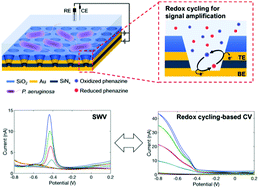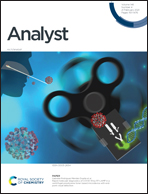Redox cycling-based detection of phenazine metabolites secreted from Pseudomonas aeruginosa in nanopore electrode arrays†
Abstract
The opportunistic pathogen Pseudomonas aeruginosa (P. aeruginosa) produces several redox-active phenazine metabolites, including pyocyanin (PYO) and phenazine-1-carboxamide (PCN), which are electron carrier molecules that also aid in virulence. In particular, PYO is an exclusive metabolite produced by P. aeruginosa, which acts as a virulence factor in hospital-acquired infections and is therefore a good biomarker for identifying early stage colonization by this pathogen. Here, we describe the use of nanopore electrode arrays (NEAs) exhibiting metal–insulator–metal ring electrode architectures for enhanced detection of these phenazine metabolites. The size of the nanopores allows phenazine metabolites to freely diffuse into the interior and access the working electrodes, while the bacteria are excluded. Consequently, highly efficient redox cycling reactions in the NEAs can be accessed by free diffusion unhindered by the presence of bacteria. This strategy yields low limits of detection, i.e. 10.5 and 20.7 nM for PYO and PCN, respectively, values far below single molecule pore occupancy, e.g. at 10.5 nM 〈npore〉 ∼ 0.082 per nanopore – a limit which reflects the extraordinary signal amplification in the NEAs. Furthermore, experiments that compared results from minimal medium and rich medium show that P. aeruginosa produces the same types of phenazine metabolites even though growth rates and phenazine production patterns differ in these two media. The NEA measurement strategy developed here should be useful as a diagnostic for pathogens generally and for understanding metabolism in clinically important microbial communities.



 Please wait while we load your content...
Please wait while we load your content...
